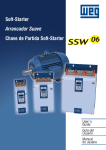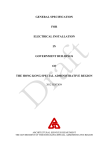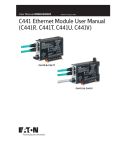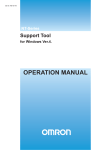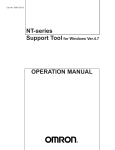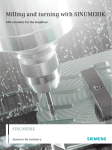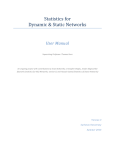Download RIDE THROUGH TECHNOLOGY
Transcript
Skinner BA and Ward G Proc S Afr Sug Technol Ass (2015) 88: 151 - 159 REFEREED PAPER RIDE THROUGH TECHNOLOGY SKINNER BA1 AND WARD G2 1 1 Montgomery Road, Mount Edgecombe, 4300, South Africa 51 Island Circle, River Horse Valley Business Estate, Durban, South Africa 2 [email protected] [email protected] Abstract The rigid grid and spare capacity that was available in sugar mills are now a thing of the past. Many sugar mills are, or shortly will be, connected to a national grid and co-generating to derive a secondary income stream. The dips (brownouts) and disconnections (blackouts) with varying durations tend to ‘blackout’ the factory with the resultant losses and stresses that go with the restart. The ability to ‘ride through’ on critical equipment such as boiler fans, boiler feed water and fuel feeders becomes essential to any protection and control philosophy and needs to be part of any sustained plan of operation for a sugar cane mill. Keywords: variable speed drive, VSD, soft-starter, UMC, ride through, energy recovery Introduction Ride through requirements stem from the need to keep equipment running. While trying to sustain the motion, all safety aspects must be covered and no compromise is acceptable. The method of sustaining the ride through depends on the method of starting. Merely keeping a motor supply energised until the supply is restored to full value is not correct or safe. The methods covered in this paper will be from the most simplistic to advanced variable speed drive (VSD) control. The full comprehension of the desired outcome and the limitations of how to achieve it must be considered. For this paper we will confine the discussion to three phase induction motors. Defining a dip There is a very technical description contained within the IEC 61000-4-11:2004 Edition 2 [2], “Voltage Dip - a sudden reduction of the voltage at a particular point of an electricity supply system below a specified dip threshold followed by its recovery after a brief interval.” It continues in a 29 page document which is highly complex and may not meet the definition of what is happening in your plant. A shortened definition is a “Voltage dip is commonly defined as any low voltage event between 10 and 90% of the nominal RMS voltage lasting between 0.5 and 60 cycles.” For the definition within this paper, this can be stated as the point at which the interruption takes effect on the electrical system to when the voltage recovers sufficiently to allow normal operation. From the nominal voltage, Un, the voltage is lowered until the contactors drop out (including soft-starter) or the drive becomes unstable. The recovery point where the contactors can pull in again is the recovery point. This is regardless of whether the driven 151 Skinner BA and Ward G Proc S Afr Sug Technol Ass (2015) 88: 151 - 159 system is energised by an external power supply or not as it is the power side that is relevant. This also covers a total black out (see Figures 1-3). Figure 1: NRS 048-4: 1999 Annexure B. Dip characteristics.[6] Figure 2: NRS 048-4: 1999 Annexure B. Dip characteristics.[6] Figure 3. Graphic view of power dips.[5] 152 Skinner BA and Ward G Proc S Afr Sug Technol Ass (2015) 88: 151 - 159 Defining ride through[1] There are two types of ride through. Firstly the power ride through where the output current to the motor is maintained and secondly, the logic ride through where the control circuit is kept active and ready to reconnect to the motor when the line power is restored. Extended definition of ride through The following examples would be for standard contactor systems as well as for electronically driven systems as these examples are more outcome defined[3]: Short duration where the motor keeps running. Longer duration where the motor comes to a stop and is automatically restarted after a delay. Long low voltage situation which triggers an error. Two dips within a short period of time. Motor characteristics To correctly achieve the full ability of the ride through it is necessary to comprehend what the motor is capable of and what the limitations are. The required torque output is defined by the load and the speed constraints. The available voltage will then be the next required input. Then look at the load and decide how to start it with the electrical and mechanical limitations. Typically small loads can be started direct on line (DOL), but so can large loads that have a sufficiently stiff electrical supply, with the ability of the load to handle a shock start. Starting will require somewhere between 6-10 times full load current depending on the load and motor type. The torque is proportional to the square of the voltage (nominal), so if the voltage drops, the torque drops by the square root. Likewise if the voltage rises, the available torque goes up by the square. If the torque reduces due to a loss in voltage and the power demand remains the same, the current goes up. As the current goes up the voltage reduces. This loop continues and the speed reduces until there is insufficient torque to rotate the shaft and the curve rises from minimum torque to locked rotor torque, where the current goes to the locked rotor value (Figure 4). Loss of rotation Normal running position Figure 4. Typical torque speed curve for an induction motor.[4] 153 Skinner BA and Ward G Proc S Afr Sug Technol Ass (2015) 88: 151 - 159 Motors should be selected for their required characteristics, but normally a general purpose motor will be used (Figure 5). Figure 5. Torque speed curves specific design.[4] In Figure 5, the design characteristics for specific requirements can be seen. Design N is the regular motor design where standard torque values are required. It has low slip and is used on pumps, machine tools fans and the like. Design H has a high locked rotor torque with a low slip. These are specific for high starting torque applications such as screens, conveyors, high inertia loads and crushers. Design D is for high locked rotor torques and high slip (above 5%). These are specifically for applications such as eccentric presses and machines with periodic loads. Starting curves When you attach a load to a motor it will behave according to the load. With a fan or centrifugal pump, the torque curve increases exponentially with speed as the blades move more and more mass. With a conveyor, the torque rises very steeply and then flat-lines. A centrifugal pump has very little inertia as the liquid acts as a brake. With a fan, particularly one with dampers that close, a huge amount of inertia is present that could result in several tens of minutes to stop. A conveyor stops within one or two seconds so the available inertia is very low and the time period very short. Method 1. Keeping the contactor energised from a remote UPS system. This is a power ride through where the control voltage is supplied via an independent power supply, and when the supply to the starter is removed, the contactor is kept closed. The motor begins to lose speed until it may even be at standstill but the contactor remains energised. The best case is where the motor is at standstill and when the power is restored, the motor accelerates as if it were started direct on line (DOL). If the motor is still turning, it generates its own voltage onto the stator and when the power is restored, the phasor difference in the voltages may result in currents as high as 12-16 times full load current (FLC) in the worst case. 154 Skinner BA and Ward G Proc S Afr Sug Technol Ass (2015) 88: 151 - 159 This system is best controlled with short duration brownouts of loss of 15-30% of nominal speed for durations of 300 to 500 milliseconds. This is preferred as opposed to blackouts or total loss of power where the motor is freewheeling when the power is restored. The duration is controlled with a high accuracy timer once the level of inertia and degradation rate of the motor shaft is ascertained. This system is prone to tripping on restoration of the voltage to nominal levels. This can be used on high speed conveying systems which take more than one second to come to a standstill. Method 2. Use of universal motor controllers The universal motor controller (UMC) is an independent electronic control and protection system. Less expensive models monitor only the current input while more expensive systems monitor the voltage and current and thus can define voltage conditions as well as the current. With these two factors, real, active and reactive power can be calculated in addition to the power factor and low load conditions. The device not only acts as a protection relay but control system too. It is supplied by a 24V DC UPS supply. If contactors of another voltage are used on larger power devices, these must be on UPS at that voltage as well. There is sufficient intelligence within the relay that once you have programmed the motor nominal data into it, it understands the parameters of the motor. When setting the ride through duration it is able to make small compensations for the initial inrush current which may prevent tripping. The UMC is intelligent enough to disable any protection functions such as low voltage, low power factor, but conflicts in setup need to be checked for. It can be programmed to restart within a specific time period if required. This can be used on remote, unmanned pump stations. Method 3. Soft-starters The WEG SSW06 soft-starter is used for this example (Figure 6). The parameters required are: P600, Immediate undervoltage. P601, Immediate undervoltage time. P610, Phase loss or immediate undercurrent (%In of the motor). P611, Immediate undercurrent time or phase loss. P616, Undercurrent before bypass closing. P630, Time interval after stopping. Can be used as a safety function. P206, Auto-Reset Time. Initiate restart after power has been restored. This function can be used on remote pump stations. Warning. The P206 function is dangerous and a Risk Analysis needs to be conducted. Sufficient training is required, and signage must be put in place. 155 Skinner BA and Ward G Proc S Afr Sug Technol Ass (2015) 88: 151 - 159 Figure 6. WEG SSW06 actuation levels for undervoltage and overvoltage.[7] As the soft-starter has a standard input for a dedicated power supply, no special additional cost is involved for this specific function. The method involves keeping the by-pass and main contactors energised for the duration of the programmed dip or blackout. When the power resumes, it is as if the DOL has had the contactor retained as in the first method. Larger soft starters should be used, i.e. de-rating the soft start, as the starting current with a full load could be very excessive and the settings may be required to be adjusted accordingly. Warning. The reasoning behind the soft-starting requirement needs to be fully understood to ensure that the electrical supply and/or the load can take the shock load of the restart. The combined switch-on current on multiple starters on a single supply may exceed the main breaker protection limitations and trip. This may be overcome by varying some of the time duration parameters to cascade the starting. Method 4A. VSD with power ride through: Capacitive storage In Figure 7, at T1, the power is lost to the drive. Energy is stored in the capacitors and power is maintained to the motor utilising this energy, but the voltage level drops quickly. The logic ride through is invoked between T2 and T3, where the rate of decay is much less as the drive is not producing power to the motor. At T3 the power is restored. The bus voltage is maintained at a higher level in a pre-charge method when the voltage drops to below a level where the motor can accept energy. This prevents a sudden inrush if power is restored. At T4 the DC bus is above the pre-charge level and the drive resumes. At a lower voltage, the DC link will fault and the drive will trip. This is indicated by the continued decay line to where it crosses the minimum % DC bus line. 156 Skinner BA and Ward G Proc S Afr Sug Technol Ass (2015) 88: 151 - 159 Figure 7. Pre-charge[1]. The time period of the ride through is a function of the difference between the 100% DC bus V1 and The point where the drive goes into pre-charge mode seen here as 85%, V2. As the energy in Joules is in watt-seconds and derived from the capacitance C and the square of the DC link voltage: J = ½ C (V12 – V22) To extend this ride through time a battery backup can be added to the DC bus. An alternative to this would be to utilise the large inertia load to generate power into its DC bus and link that bus to the critical drive bus. The larger, high inertia load is then used to drive the smaller, more critical load as discussed in method 4B below. Method 4B. VSD power ride through: Inertia driven ride through In this method, the load must be from a high inertia load where the output of the drive can be used to ensure that the pre-charge levels can be maintained for long durations and thus when the power is restored, the drive computes the revolving flux into a speed and the drive accelerates away smoothly. This is achieved by using the motor as an induction generator and reversing the current flow so it flows into the drive and charges the capacitor DC link. Calculations on duration are more difficult as mass and inertia are required and the mechanical characteristics of the rotating mass may not be easy to come by, especially in older plants. Trials should be conducted and during these trials the best duration can be decided upon. There are methods to extend the ride through time and even cope with single phasing that dips below the 50% level. A separate boost converter can be used to supply the DC bus from an independent power source such as a UPS. Another way is by the use of an active front end where the input power bridge, which now looks like the output bridge, is used to draw more current as the voltage drops. This will be a further drain on the power supply and must be catered for in the design, and the risk benefit should be fully considered. A 25% drop in voltage will be accompanied by a 33% increase in current. This cost can be quite considerable. 157 Skinner BA and Ward G Proc S Afr Sug Technol Ass (2015) 88: 151 - 159 The ‘Voltage Head Room’ method is a less expensive alternative to the above variation. The drive bus can be set up for the lower voltage from the high voltage drive, but the drive will still produce the required RMS output voltage but with some elevated voltage spikes. The motor must be able to handle these spikes. Then you could purchase a drive at a higher voltage (690v) and control the output voltage (400v). This would enable the DC bus to be operated from a higher voltage source to provide the voltage head room. Method 5. VSD: Logic ride through Here the drive logic is maintained even though the drive is not delivering an output. As indicated in the Allan Bradley paper[1], there may be limitations imposed by manufacturers where the legal compliance is required and by way of example the UL (Underwriters Laboratory) in the USA requires that the drive have less than 50 volts on any internal component within one minute of a power shut down. This would limit the duration of this ride through if this drive was purchased. The term flying start is used where voltage feedback is used to ascertain the speed and the value for the incoming voltage when the drive goes live again. The use of an encoder will enhance this method and speed up the reconnection as the drive is not able to calculate speed from slip, and generally will start at zero Hertz and work its way up until it finds the correct value. This may take a few seconds. This method is limited to about 85% of Un. ‘Run On Power Up’ is similar to the delay on start function of the UMC and is used when there are remote machines requiring a restart after coming to a complete standstill after a power interruption. Which Method to use? It is critical that the control and protection philosophy be completed so that the entire process can be worked through and a full comprehension achieved before embarking on this road. Starting, with methods to stopping the load, should be an initial point as once the ride through is achieved, it is critical that the stopping method be established and verified. Cost is always a critical consideration but the benefits should ensure the sale of the selected method to the management team. If speed variation is not required and the power loss duration is less than a second, DOL units can utilise the UPS supply with timers, or a UMC controller can be considered. If longer durations on DOL are required then a step up to a softstarter will be needed. The best method is the VSD and then if the power loss durations are over 30 seconds, the inertia method is the solution (encoder may be necessary). The final word is safety. If this method is employed to sustain your factory, full disclosure and training for everyone is required, especially when the ride through exceeds 10 seconds or the auto start after stop is employed. Persons who are active in the plant during power failures will not be expecting motors to accelerate away or automatically start when this has not happened in the history of the plant before. 158 Skinner BA and Ward G Proc S Afr Sug Technol Ass (2015) 88: 151 - 159 BIBLIOGRAPHY 1. Allan Bradley. AC Drives. 2. IEC 61000-4-11:2005 Electromagnetic compatibility (EMC) Part 4-11: Testing and measurement techniques - Voltage dips, short interruptions and voltage variations immunity tests. 3. ABB UMC manual “UMC 100-FBP issue:05.2013” 4. WEG Motors. Specification of Electric Motors. 5. Electrical Engineering Portal. Impacts of Voltage Dips on Power Quality Problems. 6. NRS 048-4:1999 Rational User Specification. Electricity Supply – Quality of supply. Part 4. Application guidelines for utilities. 7. WEG SSW06. Soft-Starter. User’s Manual. Document 0899.5854/13 159










